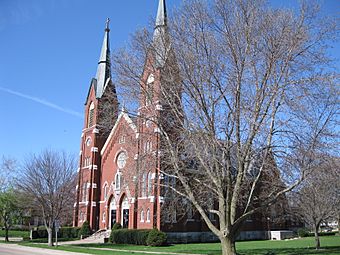St. Boniface Church (Clinton, Iowa) facts for kids
Quick facts for kids |
|
|
Saint Boniface Church
|
|
 |
|
| Location | 2500 N. Pershing Blvd. Clinton, Iowa |
|---|---|
| Built | 1908 |
| Built by | Anton Zwack |
| Architect | Martin Heer |
| Architectural style | Gothic Revival |
| NRHP reference No. | 97000386 |
| Added to NRHP | February 24, 2012 |
St. Boniface Church is a special old building in Clinton, Iowa. It used to be a Catholic church, but now it's a museum! It's called The Catholic Historical Center at St. Boniface. Inside, you can learn all about the history of Catholic people in the Clinton area. There are old items and records too. This historic church was added to the National Register of Historic Places in 2012.
Contents
The Church's Early Days
The very first Catholic Mass in the Lyons area of Clinton, Iowa, happened in 1848. Bishop Mathias Loras of the Dubuque Diocese led this service in a log home. Different priests visited the area over the years. One of them was Father Frederic Cyrille Jean. He became the first full-time priest for the first Catholic church in town, St. Irenaeus Church.
Founding St. Boniface Parish
In October 1861, German Catholic families from St. Irenaeus decided to start their own church. They called it St. Boniface Parish. They bought an old Presbyterian church building to use as their first home. Father Aloysius Meis was their first pastor, which means he was the main priest.
Starting a School for Kids
Just three years later, in 1864, St. Boniface Parish opened the first Catholic school in Clinton County. This was a big step for the community! In 1871, a group of nuns called the Sisters of Charity of the Blessed Virgin Mary came to teach at the school. Later, other nuns, the Sisters of St. Francis from Clinton, took over the teaching. The house where the priest lived, called the rectory, was built next to the church in 1873.
Growing and Changing Times
In 1891, another church, Sacred Heart Church in Clinton, started as a "mission" of St. Boniface. This meant priests from St. Boniface also took care of Sacred Heart until 1903. That's when Sacred Heart got its own full-time priest.
Father Tritz became the pastor at St. Boniface in 1901. He helped design the beautiful church building you see today. It was finished in 1908. A few years later, in 1911, all five Catholic churches in Clinton joined the Davenport Diocese. This happened when Clinton County became part of that diocese.
Merging Schools and Churches
In the 1970s, the St. Boniface school joined with the St. Irenaeus school. They formed a new school called North Catholic School. Eventually, all the Catholic elementary schools in Clinton combined. They became one big school called Holy Trinity School.
St. Boniface Parish itself officially closed in 1990. This happened when the five Catholic churches in Clinton merged into one new parish. This new parish was named Jesus Christ, Prince of Peace Parish. The new parish kept using the old church buildings for a while. St. Boniface Church finally closed its doors as a church in 2007. A brand new church for the Jesus Christ, Prince of Peace Parish was built in 2009.
Today, a special group has turned the old St. Boniface Church building into a museum. It helps people learn about the history of faith in the area.
The Church's Design and Look
The St. Boniface Church building is designed in the Gothic Revival style. This style was chosen to honor the German heritage of the people who built the church. A famous architect from Dubuque, Martin Heer, designed it.
Building the Church
The first stone of the church, called the cornerstone, was placed on June 5, 1908. The church was officially opened and blessed on November 27, 1908. Anton Zwack, a builder from Dubuque, constructed the church.
Outside the Church
The front of the church has two tall bell towers. They are topped with pointy spires, which are like tall, narrow pyramids. Above the main doors, there's a statue of St. Boniface, the church's patron saint. The outside walls are made of red brick. Blue Bedford stone is used for decoration.
Inside the Church
Inside, the church has three main sections called naves. The main altar, where the priest performs services, is at the very back in a rounded area called the apse. This high altar also has a statue of St. Boniface. It's decorated with light bulbs! This shows that Father Tritz, the pastor, was very interested in electricity. The altar was built by B. Ferring from Chicago and put in place in September 1910. The beautiful stained glass windows that let colorful light into the church were made by Munic Studio, also from Chicago.



